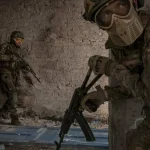Five passengers onboard the Titan submersible are believed dead after multinational search finds pieces of the vessel near the wreck of the Titanic.
A catastrophic implosion is blamed for the deaths of all five people onboard a deep-sea submersible travelling to the wreckage of the Titanic at the bottom of the Atlantic Ocean.
Here is what you need to know about the implosion of the Titan submersible.
What is a catastrophic implosion?
An implosion, the opposite of an explosion, is when an object collapses in on itself in milliseconds.
A catastrophic implosion, such as what is believed to have destroyed the Titan submersible, would have happened with incredible force and speed given the crushing water pressure on the ocean floor.
The remains of the Titanic rest on the seabed in the North Atlantic at a depth of about 4,000 metres (13,000 feet).
At sea level, atmospheric pressure is 14.7 pounds per square inch (psi), or 100 kilopascals. As you go deeper underwater, that pressure builds and builds. The water pressure at the site of the Titanic wreck is roughly 6,000 psi (more than 41,000 kilopascals).
Under this amount of pressure, even the slightest structural flaw could result in fatal consequences. Death would be virtually instantaneous for the occupants of the pressurised chamber.
What happened in the Titan submersible?
The craft submerged on Sunday morning, and its support vessel lost contact with it about an hour and 45 minutes later, the US coastguard said.
The vessel was reported overdue about 700km (435 miles) south of St John’s, Newfoundland, according to Canada’s Joint Rescue Coordination Centre in Halifax, Nova Scotia.
Its disappearance prompted a five-day multinational search.It is not clear exactly when and where the implosion occurred. But a senior US military official said on Thursday that a US navy acoustic system detected an “anomaly” on Sunday that was likely the Titan’s fatal implosion.
What caused the implosion?
That is also not clear yet.
Roderick Smith, an engineering professor at Imperial College London, said the implosion was likely due to a “failure of the pressure hull” but debris will need to be recovered to carry out a full investigation.
And even then, it may not be easy to pinpoint the cause.
“The violence of the implosion means that it may be very difficult to determine the sequence of events,” Smith said.
Who died on the tourist submersible?
The five people on board were pilot Stockton Rush, the CEO of OceanGate, the company leading the expedition; British adventurer Hamish Harding; Shahzada and Suleman Dawood, a father and son from a prominent Pakistani family; and French undersea explorer and Titanic expert Paul-Henri Nargeolet.
The White House offered its condolences.
“Our hearts go out to the families and loved ones of those who lost their lives on the Titan,” it said in a statement. “They have been through a harrowing ordeal over the past few days, and we are keeping them in our thoughts and prayers.”
Pakistan also offered its condolences to the Dawood family and to those of the other passengers.
The Harding family described the billionaire explorer as “one of a kind”.
“We adored him. He was a passionate explorer – whatever the terrain – who lived his life for his family, his business and for the next adventure. What he achieved in his lifetime was truly remarkable and if we can take any small consolation from this tragedy, it’s that we lost him doing what he loved,” a statement said.
John Paschall, Nargeolet’s stepson, told the US television network CBS that he was an inspiration.
“Science is now my favorite subject, and it was one of those things where he never forced any help. I went and asked, and he just did it,” Paschall said.
OceanGate also paid tribute to the victims, saying: “These men were true explorers who shared a distinct spirit of adventure and a deep passion for exploring and protecting the world’s oceans.”
What’s next for the search mission?
The US coastguard will continue searching near the Titanic for more clues about what happened to the Titan.
Officials said there is not a timeframe for when they will call off the international search. Rear Admiral John Mauger, of the First Coast Guard District, said the prospect of finding or recovering remains was unknown.
So far, they have located five pieces of debris. These include part of the pressure chamber, the Titan’s nose cone, the front-end bell and the aft-end bell.
Source:-Aljazeera


